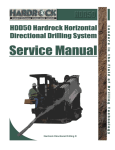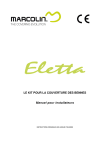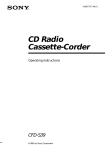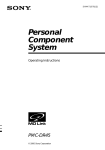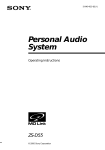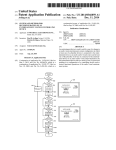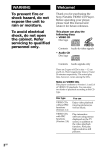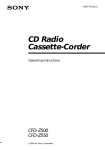Download Sony PMC-222V User's Manual
Transcript
3-862-115-11(1) Personal Component System Operating Instructions PMC-222V 1998 by Sony Corporation Warning To prevent fire or shock hazard, do not expose the player to rain or moisture. To avoid electrical shock, do not open the cabinet. Refer servicing to qualified personnel only. WARNING Do not install the appliance in a confined space, such as a bookcase or built-in cabinet. This player can play the following discs: • VIDEO CD Disc logo: Contents: Audio & video signals • Audio CD Disc logo: Contents: Audio signals only There are 2 types of CDs in size — 12 cm and 8 cm. Their longest play time is 74 and 20 minutes respectively. The actual play time, however, varies among the CDs. Note on VIDEO CDs This player conforms to Version 1.1 and 2.0 of VIDEO CD standards. You can enjoy two kinds of playback according to the CD type. Disc type You can VIDEO CDs without enjoy video playback PBC functions (moving pictures) as well (Version 1.1) as music. VIDEO CDs with PBC functions (Version. 2.0) 2 Introduction enjoy various play modes. On some Version 2.0 CDs, for instance, play interactive software using menus displayed on the TV screen, in addition to the usual video playback. Also play high-resolutive still pictures using specific types of CDs. Table of contents Basic Operations Basic Operations 4 Playing an audio CD 6 Playing a VIDEO CD 8 Listening to the radio 10 Playing a tape 12 Recording on a tape The CD Player (Audio CD) 14 Using the display 15 Locating a specific track 16 Playing tracks repeatedly (Repeat Play) 17 Playing tracks in random order (Shuffle Play) 18 Creating your own program (Program Play) 20 Playing a multiplex CD The CD Player (VIDEO CD) 21 Using the TV screen 22 Locating a specific track or scene 23 Playing a VIDEO CD with PBC functions The Radio 24 Presetting radio stations 25 Playing preset radio stations The Tape Player 26 Recording through a microphone/Using as a PA system The KARAOKE 27 Singing along the KARAOKE Setting Up 28 Hooking up the system 31 Selecting the audio emphasis (Sound Mode/MEGA BASS) Additional Information 32 Precautions 34 Troubleshooting 37 Maintenance 38 Specifications 39 Glossary Back cover Index Introduction 3 Basic Operations Playing an audio CD 3 1,2 For hookup instructions, see pages 28 - 30. 1 Press 6 PUSH OPEN/CLOSE down to open the lid of the CD compartment and place the CD on the CD compartment. With the label side up 2 3 Close the lid of the CD compartment. Press ^ (direct power-on). Display The player plays all the tracks once. Track number Playing time 4 Basic Operations Use these buttons for additional operations POWER ^ p 6 PUSH OPEN/CLOSE PREV = NEXT + Tip Next time you want to listen to a CD, just press ^ . The player turns on automatically and starts playing the CD. Basic Operations VOLUME +, – , To Press adjust the volume VOLUME +, – stop playback p pause playback ^ Press the button again to resume play after pause. go to the next track NEXT + go back to the previous track PREV = remove the CD 6 PUSH OPEN/CLOSE turn on/off the player POWER Basic Operations 5 Playing a VIDEO CD 4 1 2,3 For hookup instructions, see pages 28 - 30. 1 2 Set the COLOR SYSTEM at the rear to “NTSC” or “PAL” according to the color system of your TV. Press 6 PUSH OPEN/CLOSE down to open the lid of the CD compartment and place the VIDEO CD on the CD compartment. With the label side up 3 6 Basic Operations Close the lid of the CD compartment. 4 Press ^ (direct power-on). Display Use these buttons for additional operations POWER ^ p 6 PUSH OPEN/CLOSE Basic Operations The player starts playing the VIDEO CD. VOLUME +, – PREV = NEXT + Tips • Next time you want to play a VIDEO CD, just press ^ . The player turns on automatically and starts playing the VIDEO CD. • NTSC system countries: Japan, Korea, Taiwan, the U.S.A., etc. PAL system countries: China, India, Indonesia, Singapore, Malaysia, etc. , To Press adjust the volume VOLUME +, – stop playback p pause playback ^ Press the button again to resume play after pause. go to the next track* or scene NEXT + go back to the previous track* or scene PREV = remove the CD 6 PUSH OPEN/CLOSE turn on/off the player POWER *Only for VIDEO CDs without PBC functions (Version 1.1). Basic Operations 7 Listening to the radio 2 1 For hookup instructions, see pages 28 - 30. 1 2 Press BAND until the band you want appears in the display (direct power-on). Display Hold down TUNING + or – until the frequency digits begin to change in the display. Indicates an FM stereo broadcast The player automatically scans the radio frequencies and stops when it finds a clear station. If you can't tune in a station, press the button repeatedly and change the frequency step by step. 8 Basic Operations Use these buttons for additional operations POWER VOLUME +, – Basic Operations Tips • If the FM broadcast is noisy, press PLAY MODE•MONO/ST until “Mono” appears in the display and the radio will play in monaural. • Next time you want to listen to the radio, just press BAND. The player turns on automatically and starts playing the previous station. To Press adjust the volume VOLUME +, – turn on/off the radio POWER To improve broadcast reception FM Keep the FM aerial as horizontal as possible (see page 29). AM Keep the AM loop aerial (supplied) away as far as possible from the player and then reorient the aerial (see page 29). Basic Operations 9 Playing a tape 2 1 For hookup instructions, see pages 28 - 30. 1 Press p6 to open the tape compartment and insert a recorded tape. Use TYPE I (normal), TYPE II (high position) and TYPE IV (metal) tapes. Close the compartment. With the side you want to play facing you 2 Press ( . The player turns on (direct power-on) and starts playing. 10 Basic Operations Use these buttons for additional operations POWER p6 ,) P VOLUME +, – Tip Next time you want to listen to a tape, just press ( . The player turns on automatically and starts playing the tape. To Press adjust the volume VOLUME +, – stop playback p6 fast-forward or rewind the tape ) pause playback P Press the button again to resume play after pause. eject the cassette p6 turn on/off the player POWER Basic Operations 0 or 0 Basic Operations 11 Recording on a tape 3 1 For hookup instructions, see pages 28 - 30. 1 Press p6 to open the tape compartment and insert a blank tape. Use TYPE I (normal) and TYPE II (high position) tapes only. With the side you want to record on facing you 2 Select the program source you want to record. To record from the CD player, insert a CD (see page 4) and press p. To record from the radio, press BAND and tune in the station you want (see page 8). 12 Basic Operations Display 3 Use these buttons for additional operations POWER Tips • Adjusting the volume or the audio emphasis (see page 31) will not affect the recording level. • If the AM program makes a whistling sound after you’ve pressed r in step 3, move the AM loop aerial connected to the player as far away as possible. • To erase a recording, proceed as follows: 1 Disconnect the microphone if connected to the MIX MIC jack. 2 Turn on the power. 3 Press FUNCTION on the remote until “TAPE” appears in the display. 4 Press r . p6 P To Press stop recording p6 pause recording P Press the button again to resume recording. turn on/off the player POWER Basic Operations Basic Operations Press r to start recording. (( is depressed automatically and play starts.) 13 The CD Player (Audio CD) Using the display DISPLAY ENTER/MEM You can check information about the audio CD using the display. Checking the total track number and playing time Press DISPLAY•ENTER/MEM in stop mode. If the CD has more than 12 tracks, “OVER 12” appears in the display. Total playing time Total track number Music calendar Checking the remaining time Press DISPLAY•ENTER/MEM while playing a CD. The track numbers in the music calendar disappear after they are played. To display Press DISPLAY•ENTER/MEM the current track number and the remaining time on the current track* once remaining time on the CD and the number of tracks left twice the current track number and playing time three times * For a track whose number is more than 20 the remaining time appears as “– –:– –”. 14 The CD Player (Audio CD) Locating a specific track Number buttons PREV = NEXT + Note You cannot locate a specific track if “SHUF” or “PGM” is lit in the display. Turn off the indication by pressing p . Tip When you locate a track numbered over 10, press >10 first, then the corresponding number buttons. Example: To play track number 23, press >10 first, then 2 and 3. To locate Press a specific track directly the number button of the track a point while listening to the sound NEXT + (forward) or PREV = (backward) while playing and hold down until you find the point a point while observing the display NEXT + (forward) or PREV = (backward) in pause and hold down until you find the point The CD Player (Audio CD) The CD Player (Audio CD) You can quickly locate any track using the number buttons. You can also find a specific point in a track while playing an audio CD. 15 Playing tracks repeatedly (Repeat Play) Number buttons You can play tracks in an audio CD repeatedly in normal, shuffle or program play modes (see pages 17 – 19). MODE SELECT ( p 1 Press p . “CD” appears in the display. 2 3 Press MODE (PLAY MODE•MONO/ST on the player) until the repeat mode you want appears in the display. To repeat Select a single track REP 1 all the tracks REP ALL tracks in random order SHUF REP programed tracks PGM REP Do either of the following to start repeat play: • When you’ve selected REP1, select the track by pressing the number button (pressing PREV = or NEXT + then ^ on the player). • When you’ve selected REP ALL or SHUF REP, press SELECT ( (^ on the player). • When you’ve selected PGM REP, program tracks (see step 3 on page 18), then press SELECT ( (^ on the player). To cancel Repeat Play Press MODE until “REP” disappears from the display. 16 The CD Player (Audio CD) Playing tracks in random order (Shuffle Play) MODE SELECT ( p On the player 1 Press p . 2 Press PLAY MODE• MONO/ST repeatedly until “SHUF” appears in the display. 3 Press ^ . 1 The CD Player (Audio CD) You can play tracks in an audio CD in random order. Press p . “CD” appears in the display. 2 3 Press MODE until “SHUF” appears in the display. Press SELECT ( to start shuffle play. To cancel Shuffle Play Press MODE until “SHUF” disappears from the display. The CD Player (Audio CD) 17 Creating your own program (Program Play) Number buttons You can arrange the playing order of up to 20 tracks on an audio CD. MODE SELECT ( p On the player 1 Press p . 2 Press PLAY MODE• MONO/ST until “PGM” appears in the display. 3 Press the PREV = or NEXT + then press DISPLAY• ENTER/MEM for the tracks you want to program in the order you want. 4 Press ^ . 1 Press p . “CD” appears in the display. 2 3 Press MODE until “PGM” appears in the display. Press the number buttons for the tracks you want to program in the order you want. You can program up to 20 tracks. Programed track Playing order The programed tracks appear in the music calender. 4 18 The CD Player (Audio CD) Press SELECT ( to start program play. To cancel Program Play Press MODE until “PGM” disappears from the display. To check the order of tracks before play Press DISPLAY•ENTER/MEM on the player. Every time you press the button, the track number appears in the programed order. To change the current program Press p once if the CD is stopped and twice if the CD is playing. The current program will be erased. Then create a new program following the programing procedure. The CD Player (Audio CD) The CD Player (Audio CD) Tips • You can play the same program again, since the program is saved until you turn off the power or open the lid of the CD compartment. • You can record your own program. After you’ve created the program, insert a blank tape and press r to start recording. 19 Playing a multiplex CD On multiplex CDs, different sounds are recorded for the left and right channels. You can select either the left or the right channel and hear the sound of the selected channel. In this case, the stereo effect will be lost. ST/L/R Tip You can do the same operation using a VIDEO CD. Press ST/L/R while playing a multiplex CD. Each time you press the button, the indication and sound you hear change as follows: Press Indication You will hear once L-CH left channel sound twice R-CH right channel sound three times STEREO stereo sound The initial setting is “STEREO.” 20 The CD Player (Audio CD) The CD Player (VIDEO CD) Using the TV screen You can check the operating status of the player and the information about the VIDEO CD on the TV screen. Notes • While playing an audio CD, the OSD mode cannot be displayed on the TV screen. • When you record the playback picture of this player on another VCR, etc., be sure to select “OSD OFF”. Otherwise, the display information will also be recorded on the VCR. • The OSD mode returns to “OSD AUTO” when you turn off the player by pressing POWER or open the lid of the CD compartment. Press OSD. The CD Player (VIDEO CD) OSD Each time you press the button, the OSD (On-Screen Display) mode changes as follows: OSD AUTO OSD ON OSD OFF When “OSD AUTO” is selected, the operating status appears for a few seconds on the TV screen when you press a button or when the operating status is changed. When “OSD ON” is selected, the operating status is always displayed. Various indications displayed on the TV screen Indication What it means PBC ON PBC mode has been switched to ON PBC OFF PBC mode has been switched to OFF SELECT Waiting for you to select something (For instance, at the time of menu display) + Locating the next or succeeding tracks or scenes = Locaing the current or preceding tracks or scenes ) Searching forward 0 Searching backward STEREO Hearing stereo sound L-CH Hearing left channel sound R-CH Hearing right channel sound INVALID Inappropriate buttons were pressed The CD Player (VIDEO CD) 21 Locating a specific track or scene While playing a VIDEO CD, you can quickly locate any track or specific point in a track by observing the TV screen. Number buttons PREV = NEXT + Tip When you locate a track or scene numbered over 10, press >10 first, then the corresponding number buttons. Example: To play track (or scene) number 23, press >10 first, then 2 and 3. 22 The CD Player (VIDEO CD) To locate Press a specific track or scene directly (when “PBC OFF” is selected) the number button of the track or scene a point while monitoring the picture NEXT + (forward) or the PREV = (backward) while playing and hold down until you find the point Playing a VIDEO CD with PBC functions Using the PBC functions , you can play a VIDEO CD with PBC functions (Version 2.0) (simple interactive software, software with search functions, etc.) Number buttons NEXT + RETURN SELECT ( PBC ON/OFF Tip If you want to perform normal operations with a PBC VIDEO CD, select “PBC OFF.” Note You cannot turn PBC ON/OFF after playback starts. Select “PBC ON” or “PBC OFF” before you press SELECT ( . 1 2 Insert a VIDEO CD with PBC functions. 3 Press SELECT ( . The CD Player (VIDEO CD) PREV = Refer also to the instructions supplied with the VIDEO CD, as the operating procedure may differ according to the VIDEO CD. Press PBC ON/OFF until “PBC ON” appears on the TV screen. PBC playback starts. Follow the instructions or scenes appearing on the TV screen. When Press you want to select an item number the number buttons of the item you want, then SELECT ( on the remote MENU + or – to select the item number, then ^ on the player you want to go back to the top or the previous menus* RETURN (The actual operation varies among the VIDEO CDs. Refer to the instructions supplied with the VIDEO CDs.) you want to locate the next or succeeding scenes NEXT + you want to locate the previous or preceding scenes PREV = * Where to go back differs according to the VIDEO CD you are playing. The CD Player (VIDEO CD) 23 The Radio Presetting radio stations You can store radio stations into the player’s memory. You can preset up to 24 radio stations, 12 for each band in any order. Number buttons TUNE +, – BAND On the player 1 Press BAND to select the band. 2 Set the frequency to the station you want. 3 Hold down DISPLAY•ENTER/ MEM for 2 seconds. “PRESET” and a preset number flash. 4 Decide on a preset number for the station (1 to 12) by pressing PRESET + or –. 5 Press DISPLAY• ENTER/MEM. 24EN The Radio 1 2 3 Press BAND to select the band. Set the frequency to the station you want. Hold down the number button that you want to preset the new station on for 2 seconds. To select the preset number over 10, press >10 first, then the corresponding number buttons. You need to hold down the last number button to enter for 2 seconds. (Example: To select 12, press >10 and 1, then hold down 2 for 2 seconds.) The new station replaces the old one. Playing preset radio stations Once you've preset the stations, use the number buttons on the remote or PRESET +/– on the player to tune in to your favorite stations. Number buttons On the player 1 Press BAND to select the band. 2 Press PRESET + or – to tune in the stored station. 1 2 The Radio BAND Press BAND to select the band. Press the number buttons to tune in the stored station. To tune in a preset station over 10, press >10 first, then the corresponding number buttons. (Example: To tune in the preset station 11, press >10, and then press 1 and 1.) The Radio 25EN The Tape Player Recording through a microphone/Using as a PA system POWER ^ VOLUME +, – r You can record sound using a microphone (not supplied) or use the player as a public address system. Tip You can mix audio/ VIDEO CD or radio sounds and record them by adding your voice or other audio through the microphone. (See “Singing along the KARAOKE” on page 27.) Notes • Acoustic feedback (howling) tend to occur when you use a microphone with echo function. • If acoustic feedback (howling) occurs, turn down the volume or move the microphone away from the speaker. 26 The Tape Player MIC VOL MIX MIC Recording through a microphone 1 Plug the microphone into the MIX MIC jack and turn on the microphone if it has a power switch. 2 3 Turn on the power. 4 Insert a cassette for recording into the deck and press r to start recording. Press FUNCTION on the remote until “TAPE” appears in the display. Using as a PA system 1 2 Do steps 1 - 3 above. Sing or speak into the microphone and adjust the volume using MIC VOL or VOLUME +/–. The KARAOKE Singing along the KARAOKE ST/L/R ^ VOLUME +, – r You can sing along the KARAOKE by using a microphone (not supplied) and a KARAOKE multiplex audio/VIDEO CD. MIC VOL MIX MIC 1 Plug the microphone into the MIX MIC jack and turn on the microphone if it has a power switch. 2 Insert a KARAOKE multiplex audio/ VIDEO CD. 3 Press ^ . The KARAOKE Notes • Acoustic feedback (howling) tend to occur when you use a microphone with echo function. • If acoustic feedback (howling) occurs, turn down the volume or move the microphone away from the speaker. Play starts. 4 Press ST/L/R repeatedly until you can hear the accompaniment from both speakers. 5 Adjust the microphone volume turning the MIC VOL (volume) control. 6 Adjust the volume of the player using VOLUME + or –. 7 Starts to sing. To record KARAOKE sound and your voice 1 Insert a cassette for recording. 2 Do steps 1 to 6 above. 3 Press r (( is depressed automatically). The KARAOKE 27 Setting Up Hooking up the system AM loop aerial 5 TV 2 AM aerial terminal Make sure you turn off the power before making any connections. FM aerial to the video input jack 1 Speaker terminals Video cord Right speaker Left speaker Speaker cord 3 To a wall outlet Note Connect the supplied speakers to this player. If you connect any other speakers or equipment, a malfunction may occur. 28 Setting Up 1 Hooking up the speakers 1 Twist the speaker cable coating and strip it from the end of the cable. 2 Connect the black wire to (–) minus and the red wires to (+) plus terminals:the right speaker wires to the R and the left speaker wires to the L terminals. 2 Hooking up the aerials AM loop aerial (supplied)* FM aerial** Setting up the AM loop aerial Setting Up *Reorient the aerial to improve broadcast reception. **Keep the aerial as horizontal as possible. 3 Connecting the AC power cord Connect the AC power cord to the wall outlet. The POWER/STANDBY indicator lights up to indicate when the player is connected to the power source. The indicator lights regardless of whether the power is on or off. Note Be sure to turn off the power of the player before you set the MAIN POWER switch to OFF. 4 Setting the MAIN POWER switch Set the MAIN POWER switch on the side of the player to ON. continued Setting Up 29 Hooking up the system (continued) 5 Connecting the TV To use the VIDEO CD, connect the TV equipped with the video input jack in the following way: 1 Connect the supplied video cord to the VIDEO OUT jack of the player and the video input jack of the TV. 2 Turn on the TV and set the input mode selector on the TV to the proper position. 6 Inserting batteries into the remote Insert two R6 (size AA) batteries (not supplied) Replacing batteries With normal use, the batteries should last for about six months. When the remote no longer operates the player, replace all the batteries with new ones. 30 Setting Up Selecting the audio emphasis MEGA BASS (Sound Mode/MEGA BASS) SOUND You can adjust the audio emphasis of the sound you are listening to. Press SOUND to select the audio emphasis you want. Choose Setting Up Selecting the sound characteristic To get powerful, clean sounds, emphasizing low and high range audio percussive sounds, emphasizing bass audio the presence of vocals, stressing middle range audio the whole dynamic range for music such as classical music light, bright sounds emphasizing high and middle range audio Reinforcing the bass sound Press MEGA BASS. ”MEGA BASS” appears in the display. To return to normal sound, press the button again. Setting Up 31 Additional Information Precautions On safety • As the laser beam used in the CD player section is harmful to the eyes, do not attempt to disassemble the casing. Refer servicing to qualified personnel only. • Should any solid object or liquid fall into the player, unplug the player, and have it checked by qualified personnel before operating it any further. On power sources • The player is not disconnected from the AC power source (mains) as long as it is connected to the wall outlet, even if the player itself has been turned off. • When the batteries are not to be used, remove them to avoid damage that can be caused by battery leakage or corrosion. • The nameplate indicating operating voltage, power consumption, etc. is located at the rear. On placement • Do not leave the player in a location near heat sources, or in a place subject to direct sunlight, excessive dust or mechanical shock. • Do not place the player on an inclined or unstable place. • Do not place anything within 10 mm of the side of the cabinet. The ventilation holes must be unobstructed for the player to operate properly and prolong the life of its components. 32 Additional Information • If the player is left in a car parked in the sun, be sure to choose a location in the car where the player will not be subjected to the direct rays of the sun. • Since a strong magnet is used for the speakers, keep personal credit cards using magnetic coding or springwound watches away from the player to prevent possible damage from the magnet. On operation • If the player is brought directly from a cold to a warm location, or is placed in a very damp room, moisture may condense on the lens inside the CD player section. Should this occur, the player will not operate properly. In this case, remove the CD and wait about an hour for the moisture to evaporate. • If the player has not been used for a long time, set it in the playback mode to warm it up for a few minutes before inserting a cassette. If you have any questions or problems concerning your player, please consult your nearest Sony dealer. Notes on CDs • Before playing, clean the CD with a cleaning cloth. Wipe the CD from the center out. Notes on cassettes • Break off the cassette tab from side A or B to prevent accidental recording. If you want to reuse the tape for recording, cover the broken tab with adhesive tape. Side A • Do not use solvents such as benzine, thinner, commercially available cleaners or anti-static spray intended for vinyl LPs. • Do not expose the CD to direct sunlight or heat sources such as hot air ducts, nor leave it in a car parked in direct sunlight as there can be a considerable rise in temperature inside the car. • Do not stick paper or sticker on the CD, nor scratch the surface of the CD. Tab for side B Tab for side A • To record on a tape with its tab broken off, cover the respective tab hole for side A or B with adhesive tape. Take care not to cover the detector slots on TYPE II (high position) or TYPE IV (metal) cassettes. If the slots are covered, the automatic tape selection system will not operate correctly. • After playing, store the CD in its case. If there is a scratch, dirt or fingerprints on the CD, it may cause tracking error. TYPE II (high position) detector slots TYPE IV (metal) detector slots • The use of a cassette with more than 90 minutes of play time is not recommended except for long, continuous recording or playback. Additional Information 33 Symptom Remedy The power is not on. • Connect the AC power cord to a wall outlet securely. • Set the MAIN POWER switch on the side of the player to ON. There is no audio. • Make sure that the speakers are connected correctly. • Make sure the function you want to use appears in the display. • Adjust the volume. • Unplug the headphones when listening through speakers. “no disc“ lights in the display even when a CD is in place. • Insert the CD with the label surface up. The CD does not play. • • • • The sound drops out. • Reduce the volume. • Clean the CD, or replace it if the CD is badly damaged • Place the player in a location free from vibration. The sound seems to lose the stereo effect and becomes monaural. • Press ST/L/R repeatedly until “STEREO” appears on the TV screen. No picture appears on the TV screen. • Make sure the TV is turned on. • Make sure you select the correct video input on the TV. • Connect the video connecting cord correctly. • An audio CD is being played. • Close the lid of the player. • Make sure the following mark is on the CD. CD Player (VIDEO CD) CD Player (audio CD) General Troubleshooting 34 Additional Information Make sure that the CD compartment is closed. Place the CD with the label surface up. Clean the CD. Take out the CD and leave the CD compartment open for about an hour to dry moisture condensation. • Make sure “CD” appears in the display. • You may not play back some illegally duplicated CDs even though they have the above mark printed. In this case, consult the shops where you bought the CDs. CD Player (VIDEO CD) Radio Tape Player Symptom Remedy Picture is distorted • When you pause or use search, picture is distorted. This is not a malfunction. • The CD is defective. Replace the CD. • The CD is dirty. Clean the CD. • The color system you have selected for this player is not the same as the one the CD is recorded with. Picture is blurred or becomes monochrome. • Check the setting of the COLOR SYSTEM selector. The audio is weak or has poor quality. • Move the player away from the TV. • If you are using the remote while listening to AM radio, noise may be heard. This is unavoidable. The picture of your TV becomes unstable. • If you are listening to an FM program near the TV with an indoor antenna, move the player away from the TV. The tape does not move when you press an operation button. • Close the tape compartment securely. The REC r button does not function/The tape does not play. • Make sure the safety tab on the cassette is in place. • Make sure “TAPE” appears in the display. The tape does not erase completely. • Clean the erasing head (see page 37.) The tape does not record. • Make sure the tape is inserted properly. • Make sure the safety tab of the cassette is in place. The audio is weak/The audio quality is poor. • Clean the heads, pinch roller and capstan (see page 37). • Demagnetize the heads using a demagnetizer (see page 37). The sound is distorted. • A TYPE IV (metal) tape was used when recording with this player. n Record on TYPE I (normal) or TYPE II (high position) tapes only. continued Additional Information 35 Troubleshooting (continued) Remedy The remote does not function. • Replace all the batteries in the remote with new ones if they are weak. • Make sure that you are pointing the remote at the remote sensor on the player. • Remove any obstacles in the path of the remote and the player. • Make sure the remote sensor is not exposed to strong light such as direct sunlight or fluorescent lamp light. • Move closer to the player when using the remote. Remote Symptom After trying the above remedies, if you still have problems, unplug the AC power cord. After all the indications in the display disappear, plug the power cord. If the problem persists, please consult your nearest Sony dealer. 36 Additional Information Maintenance Cleaning the lens If the lens becomes dirty, it may cause a skipping of sound during CD operation. Clean with a commercially available blower. Cleaning the tape heads and tape path Wipe the heads, the pinch roller and the capstan with a cleaning swab slightly moistened with cleaning fluid or alcohol after every 10 hours of operation for optimum playback and recording quality. To make the best possible recording, however, we recommend that you clean all surfaces over which tape travels before each recording. Record/Playback head Erase head Demagnetizing the tape heads After 20 to 30 hours of use, enough residual magnetism will have built up on the tape heads to begin to cause loss of high frequency sound and hiss. At this time, you should demagnetize the heads and all metal parts in the tape path with a commercially available tape head demagnetizer. Cleaning the cabinet Clean the cabinet, panel and controls with a soft cloth slightly moistened with a mild detergent solution. Do not use any type of abrasive pad, scouring powder, or solvent, such as alcohol or benzine. Capstan Pinch roller Lens After cleaning, insert a tape when the areas cleaned are completely dry. Additional Information 37 Specifications CD player section General System Compact disc digital audio/video system Laser diode properties Material: GaAlAs Wave length: 780 nm Emission duration: Continuous Laser output: Less than 44.6 µW (This output is the value measured at a distance of about 200 mm from the objective lens surface on the optical pick-up block with 7 mm aperture.) Spindle speed 200 r/min (rpm) to 500 r/min (rpm) (CLV) Number of channels 2 Frequency response 20 - 20,000 Hz +1/-2 dB Wow and flutter Below measurable limit Color system format NTSC, PAL Speaker Full range: 10 cm (4 in.) dia., 6 ohms, cone type Tweeter: 2 cm (4⁄5 in.) dia. Inputs Mixing microphone input jack (minijack): Sensitivity 2.5 mV For 16 - 68 ohms impedance headphones Outputs Headphones jack (stereo minijack) For 16 - 64 ohms impedance headphones Video output (phono jack) Output level 1 V p-p at 75 ohms Recommended load impedance over 75 ohms Maximum power output 30 W + 30 W Power requirements For CD radio cassette-corder 230 V AC, 50 Hz For remote control: 3 V DC, 2 R6 (size AA) batteries Power consumption AC 55 W Dimensions (incl. projecting parts and controls) Player: Approx. 160 × 237 × 292.5 mm (w/h/d) (6 3⁄8 × 9 3⁄8 × 11 5⁄8 inches) Speaker: Approx. 150 × 230 × 240 mm (w/h/d) (6 × 9 1⁄8 × 8 1⁄2 inches) Mass Player: Approx. 4.9 kg (10 lb 13 oz) Speaker: Approx. 2.2 kg (4 lb 14 oz) Supplied accessories Remote control (1) AM loop aerial (1) Video cord (1) Radio section Frequency range FM: 87.6 - 108 Hz AM: 531 - 1,602 kHz Aerials FM: Wire aerial AM: External aerial Cassette-corder section Recording system 4-track 2 channel stereo Fast winding time Approx. 120 s (sec.) with Sony cassette C-60 Frequency response TYPE I (normal): 80 - 14,000 Hz TYPE II (high position): 80 - 15,000 Hz Design and specifications are subject to change without notice. Optional accessories Sony MDR headphones series 38 Additional Information Glossary PBC Playback Playback using the menus* recorded on VIDEO CDs with PBC functions. You can enjoy simple interactive operations using the PBC Playback. Playback Control (PBC) Signals encoded on VIDEO CDs (Version 2.0) to control playback. By using menus* recorded on VIDEO CDs with PBC functions, you can enjoy playing simple interactive software, software with search functions, and so on. When you insert a VIDEO CD with PBC functions on this player, “PBC” appears on the display. VIDEO CD A compact disc containing moving pictures. Picture data is compressed to 1/120th of the original data in the MPEG 1 format (one of the worldwide standards of digital compression technologies) and recorded on a disc. A 12 cm VIDEO CD can reproduce up to 74 minute’s length of moving pictures. Audio data is also compressed so that a VIDEO CD can contain 6 times as much audio data as an audio CD. There are 2 versions of VIDEO CDs. • Version 1.1: You can play only moving pictures and sounds. • Version 2.0: You can play still pictures* and enjoy PBC functions. * Please note that what you can do with the Version 2.0 VIDEO CD differs according to the CD you use. Additional Information 39 Index A K R Audio emphasis 31 KARAOKE 27 Radio stations playing 25 presetting 24 Recording on a tape 12 Repeat Play 16 B L Batteries for remote 30 Listening to the radio 8 Locating a specific track 15, 22 C CD player 14 Cleaning cabinet 37 lens 37 tape heads and tape path 37 Creating your own program 18 D, E, F, G Demagnetizing the tape heads 37 Display 14 H Hooking up power cord 29 speakers 28 I, J Improving broadcast reception 9 40 Sony Corporation Additional Information S M, N, O MEGA BASS 31 P, Q PA system 26 Playing a tape 10 a multiplex CD 20 a VIDEO CD 6 a VIDEO CD with PBC functions 23 an audio CD 4 preset radio stations 25 tracks repeatedly 16 PBC 2, 23, 39 Power sources 28 Presetting radio stations 24 Program Play 18 Public address system. See PA system Selecting audio emphasis 31 tracks 5 Setting up 28 SOUND 31 T Tape player 26 Troubleshooting 34 U, V, W, X, Y, Z Using as a PA system 26 the display 14








































